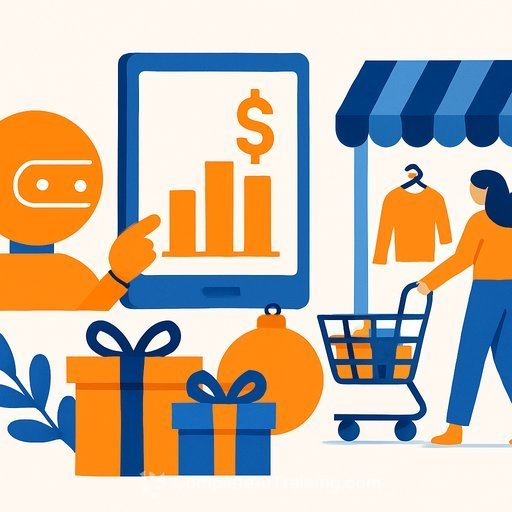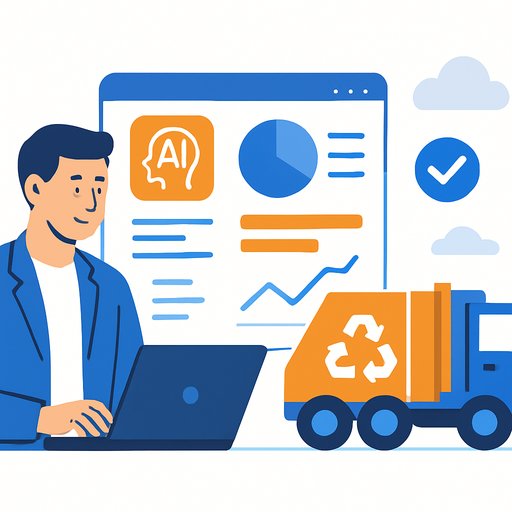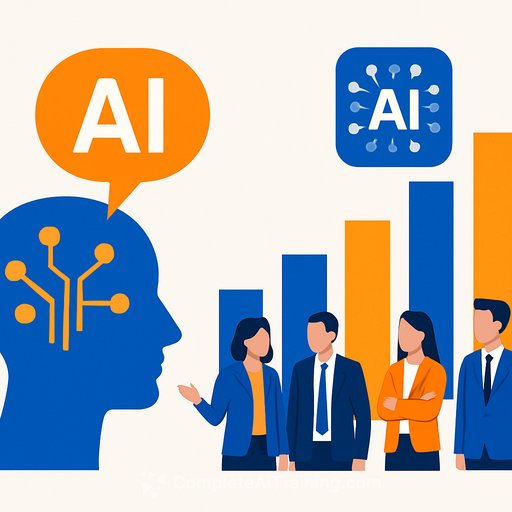Holiday 2025: AI Agents Are Rewriting Product Discovery - Here's How Sales Wins
Product discovery is shifting fast. Salesforce projects that AI - especially agentic search - will influence a large slice of holiday demand, while discounts rise and stores stay essential.
If you sell, this is your map for where demand will come from, what buyers will expect, and how to capture the upsides without burning margin.
Consumer behavior snapshot to set your targets
- LLM search is climbing: U.S. consumers starting with an LLM grew from 6% in May to 9% by August. Boomers moved from 0% to 3% adoption.
- Agentic search is in the journey: 20% of U.S. consumers use AI agents at some point before purchase.
- Value focus remains: Shoppers report buying less, prioritizing essentials, and trading down to lower-priced goods.
The 5 Salesforce holiday predictions that matter for sales
1) Online holiday sales will break records
Forecast: $1.25T in global online sales (+4% YoY). U.S. online sales projected at $288B (+2.1%).
- Country highlights: Canada $14.7B (+2%), France $14.9B (+8.3%), Germany $20.2B (+3.2%), Italy $11.3B (+15.6%), Spain $11.3B (+15.6%), U.K. $38.5B (+6.5%).
- Recalibrate quotas and capacity for a low-single-digit uplift, with heavier spikes on deal days.
- Lock inventory and fulfillment SLAs now for peak weeks; prioritize fast movers and giftable bundles.
- Push store-linked fulfillment (BOPIS/ship-from-store) to protect conversion when carriers bottleneck.
2) The average discount rate will increase YoY
Cyber Week: U.S. and Canada projected to average 29% off. For the full season, Canada leads at 23% average discounts, slightly above the U.S. and global averages.
- Biggest Cyber Week cuts by category: General apparel 37%, Health & beauty 35%, Home 23%.
- Use tiered offers tied to AOV thresholds to grow basket size while controlling margin.
- Prioritize category hero SKUs for deep cuts; keep attach items at lighter discounts to protect profit.
- Sequence "price drops" with limited-time perks (fast shipping, gift wrap, easy returns) instead of sitewide codes.
3) Agentic AI will drive nearly a fifth of U.S. online holiday sales
Forecast: $263B in global online sales influenced by AI and agents; $51B in the U.S. That reflects consumers using AI to find and decide, even if checkout happens elsewhere.
- AI-referred traffic grew 119% YoY in H1 2025 and converts 700% higher than social, and 200% higher than other channels (excluding social).
- 57% of U.S. AI users engage agentic search in physical stores; 87% trust AI recommendations (up from 45% in May).
- Make your catalog "assistant-ready": natural-language product copy, clear use-cases, compatibility notes, and FAQs that answer nuanced questions.
- Publish structured details (sizes, materials, warranties, return windows) so assistants can parse and compare easily.
- Deploy an on-site assistant for pre-sale guidance and handoff to reps; track "assistant" UTMs as a distinct source.
- Equip store teams with quick scripts for AI-assisted shoppers: "Show me the eco-friendly version," "What solves X under $50?"
4) Tariffs push more buyers to resale
About half of U.S. consumers plan to gift a resale item. Globally, Salesforce expects $64B in holiday online sales from resale. Top reasons: saving money (70%), availability (33%), sustainability (25%), convenience (25%). 20% of U.S. secondhand buyers cite tariffs.
- Spin up or spotlight certified refurbished, trade-in credits, and "like-new" gift options with warranties.
- Message price transparency: side-by-side "new vs. certified refurbished" value and savings.
- Expect a 2% decline in promo-code checkout usage; shift to auto-applied deals and cart-level offers.
5) Physical stores will be prominent
Top destinations: online marketplaces (79%) and physical stores (76%), followed by retailer sites (41%), brand sites (38%), social (24%), and delivery apps (14%).
- Last season, 83% of holiday retail sales came from stores. Two in three U.S. Gen Z shoppers plan to buy in-store this season.
- Reasons: experience, instant pickup, tactile evaluation, and easier browsing. For every $1 Gen Z spends online, they spend $3 in stores.
- Bridge channels: QR codes to product guides, store-only bundles, and "see it in-store" locators on PDPs.
- Promote BOPIS and reserve-online/pick-up to recover "out-of-stock online" losses.
- Train associates on value framing and comparison talking points sourced from common AI queries.
Quick sales checklist for Nov-Dec
- Update forecasts with +2-4% online uplift; model steeper spikes around Cyber Week.
- Set discount guardrails by category; pair deep cuts with profitable add-ons.
- Standardize product copy for assistants: problem-solution, who it's for, key specs, care, warranty.
- Enable assistant-friendly content: comparison guides, sizing help, compatibility, and troubleshooting FAQs.
- Instrument "AI/assistant" referral tagging across web, store QR, and clienteling links.
- Stand up or highlight resale/certified refurbished with clear guarantees.
- Double down on store conversion: BOPIS promises, endcaps for giftable bundles, clear signage on key deals.
- Pre-build "good/better/best" bundles for value-focused shoppers.
- Align staffing to peaks; script objection handling for price-sensitive and trade-down buyers.
Key dates and targets to anchor your offers
- Cyber Week: Plan around an average 29% discount in the U.S. and Canada.
- Category focus: Apparel ~37% off, Health & Beauty ~35%, Home ~23% during Cyber Week.
- AI capture: Treat assistant-driven discovery as a primary source; test assistant-specific landing pages.
Resources
Your membership also unlocks:






